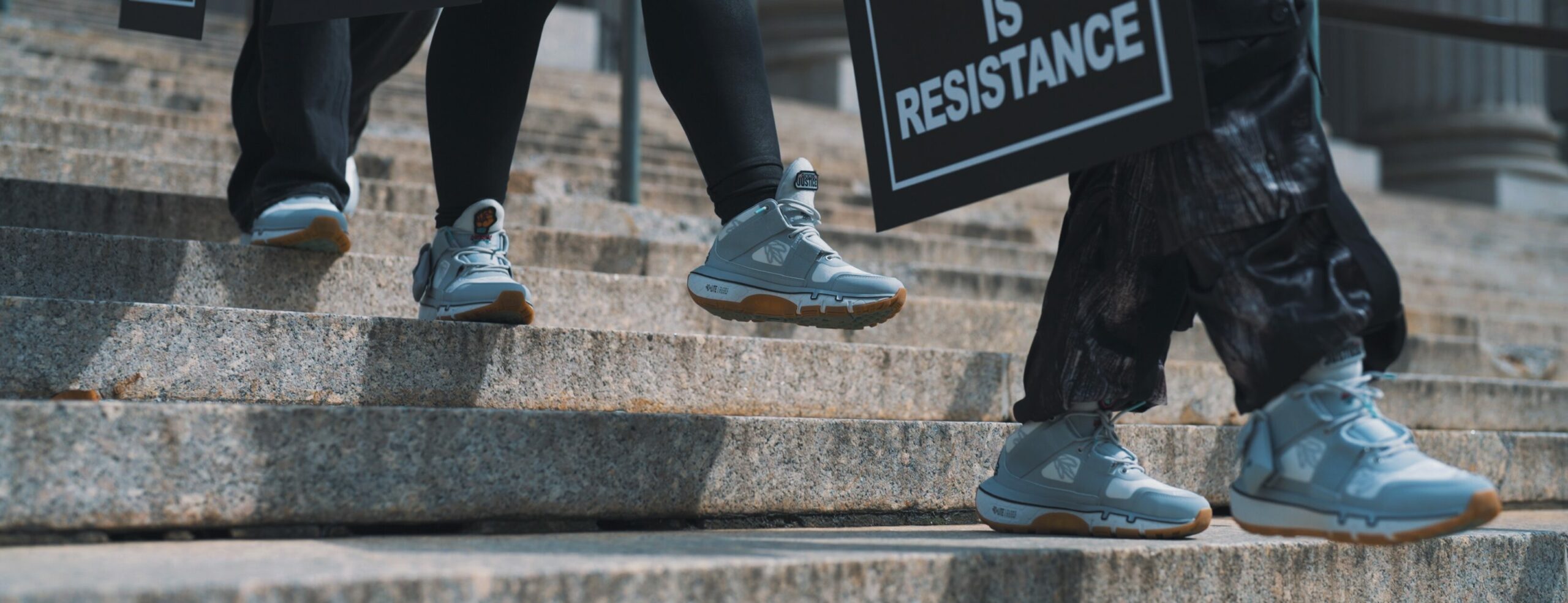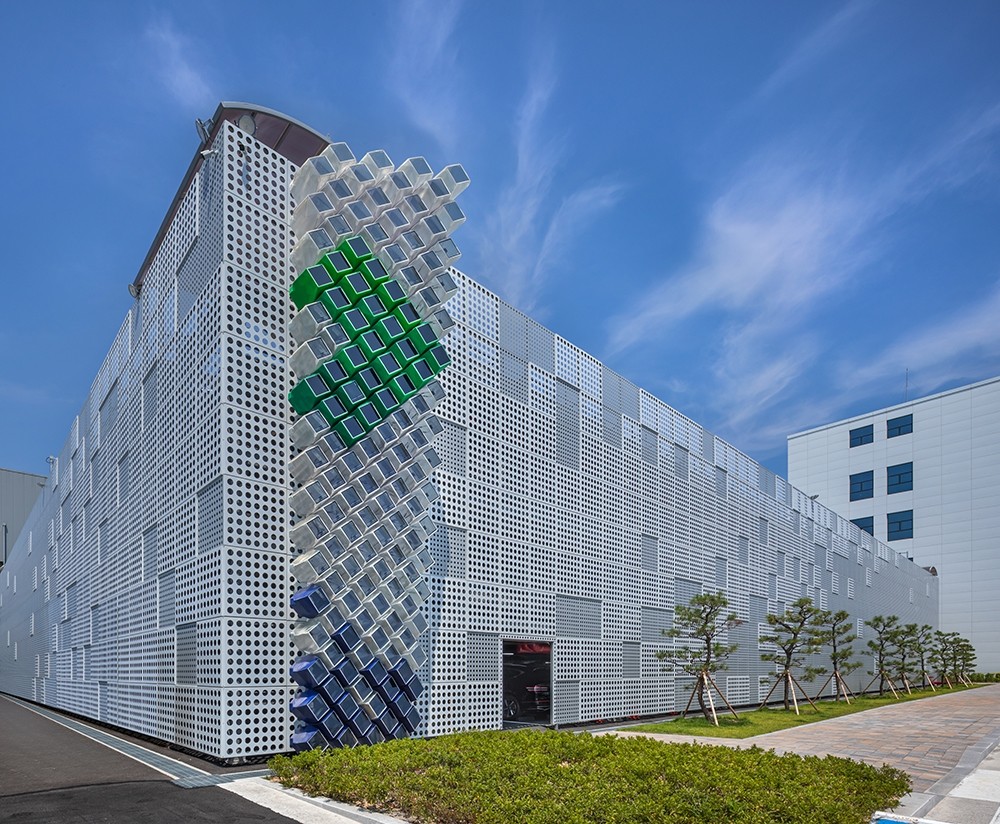Matthew Drazic didn’t just start a sneaker brand; he walked away from corporate America to build something with real impact. After designing for New Balance, Diesel, Converse, and Rykä, he founded AGENCY Footwear in 2023, driven by a simple but powerful idea: shoes should support those fighting for change, not just fuel the system they’re up against.
This is where the Guardian Storm steps in. More than just a sneaker, it’s a statement built for activists, designed with sustainability in mind, and carrying the message “For the kids.” It’s no surprise AGENCY Footwear was named Brand of the Year at the Global Footwear Awards 2024.
In this interview, Drazic talks about breaking away from the status quo, the irony of launching a consumer brand in a consumer-driven world, and why he believes the right pair of sneakers can help change the system.
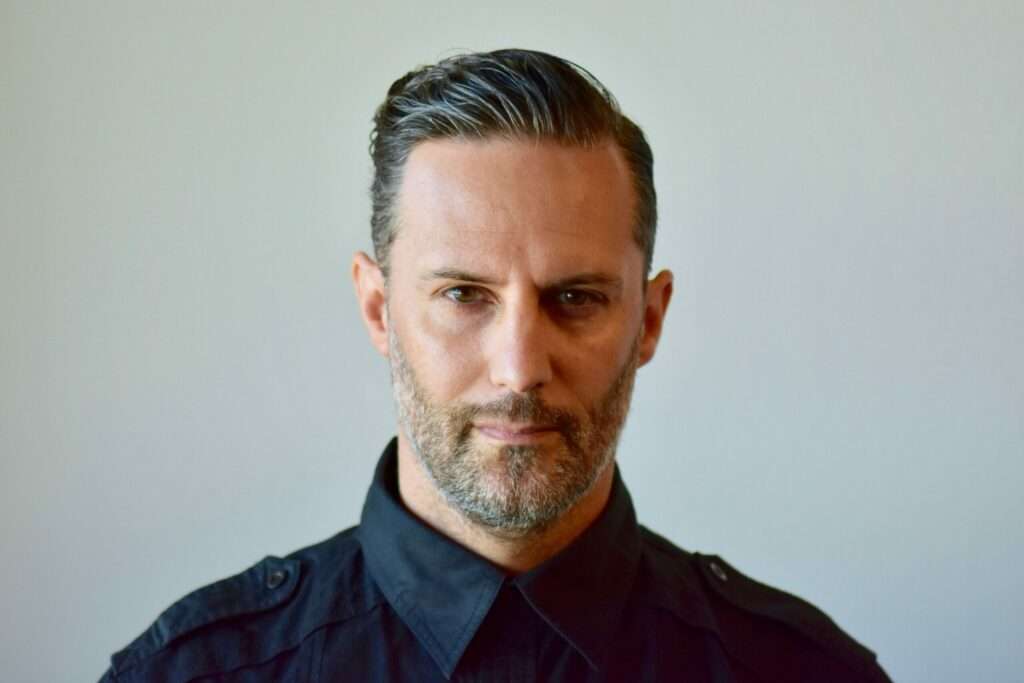
Interview with Mathew Drazic
Can you tell us a bit about your background? How did you create Agency and what shaped your vision for the brand?
I actually had a somewhat traumatic childhood in the working-class suburbs of Seattle, in a state I didn’t realize was 95% white and named after a lionized enslaver. But it wasn’t all bad. I attended a surprisingly multi-cultural high school in a district that had great vocational programs where I studied graphic design and architecture for 4hrs a day my entire senior year. That’s when the dream of playing pro soccer faded, and instead, I competed on the traveling graphic design team. After learning architecture was a saturated field, I attended a small state university 20 minutes from Canada to study industrial design where I created a 3rd year independent study in footwear design. After that, my professor helped me get an internship at Converse in Boston, where I completed the blueprint for Dennis Rodman’s first signature shoe.
Simultaneously, I had a kid on the way, so I abandoned my education and got my first real job working for Michael Rubin in 1996 in King of Prussia, Pennsylvania. I designed Karl Malone’s Apex signature shoe at 21 years old when he was the league MVP, then went to work under 4 powerhouse women from Nike and Adidas as they rebuilt Rykä at a satellite office in Portland, OR. Next was New Balance back in Boston and Diesel in Santa Barbara, where I excelled creatively but felt demotivated by the predatory nature of business. So, at the end of 2005, I chose to work with a friend and former lead designer at NB in Milwaukee, WI, to help transition a heritage dress shoe company from a reactive business model to a proactive one where design could lead the way. That’s where I learned just how difficult culture change can be while also inadvertently undermining my career path with the big brands.
During my career, I consistently volunteered in underserved communities as well, which is where I saw the massive disparity in resources America allocates to various regions. Such as when I mentored foster youth in Los Angeles to help them improve in reading and mathematics while I worked for a company whose main client was Target.
The vision for AGENCY comes from my personal experience working to end a cycle of generational trauma combined with my professional answer to the question: “How can a brand justify selling $200 sneakers to foster kids on welfare?” Apparently, for some companies, the answer is to help them become better ball players, but for me, the answer is only if the company uses every resource available to create a better future for all children. That’s why it says “for the kids” on the right footbed of every shoe under a drawing of my daughter when she was 3.
I created AGENCY by first-hand drawing iconography in support of the design ethos, “Inspired by and Designed for Everyone Helping the World: Embrace Equality, Heal the Planet, and Change the System to Fix the Future.” One of the biggest challenges has been turning “a better future for all children” into an immediately understandable brand identity. It required a lot of research on the history of social change, and reading Frantz Fanon is where I connected with the legacy of those who came before me through his use of the word “agency.” After that, it was a matter of learning the patent and trademark system, along with business documentation.
What would you say is your personal design philosophy? Has this philosophy influenced Agency Footwear’s approach to creating products with a deeper purpose, like the Guardian sneaker?
As someone who tried to innovate at every design review only to be shot down hundreds of times by sensible businesspeople, I developed a philosophy of “unique but familiar” that’s allowed me to design creative products with the potential to sell in volume. It also helped me shape the AGENCY Guardian into a wearable silhouette with unique features, such as the dynamic Mid-Foot Strap that I’m trying to patent.
The deeper purpose of the shoes comes from who they’re designed for and the understanding that social change is typically sparked when marginalized people are forced to become activists. That inspired me to treat them as the heroes of the product story.
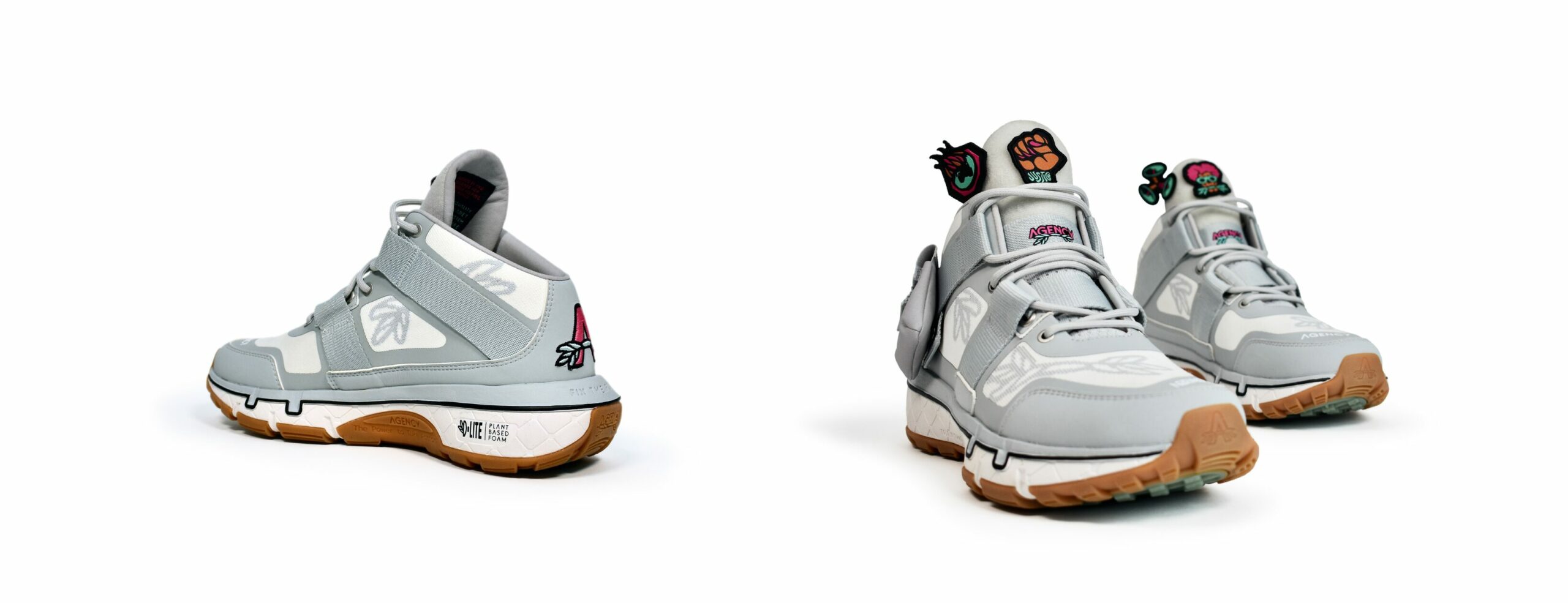
Could you share the story behind the creation of the Guardian sneaker and why you decided to use materials like plant-based foam, vegan leather, and recycled textiles?
The story of the Guardian is one of providing a worthwhile option for activists. I wanted it to perform when it was needed most while also being super comfortable when walking for hours on end, kind of like an SUV. That informed pretty much everything about the shoe. The last has a wide toe box to allow the forefoot to naturally splay for all-day comfort. The two straps secure the shoe around the foot while also creating a purposeful aesthetic. The knit provides comfort in the flex zone and increased breathability when things get heated. While the dual-density Triple Threat Midsole provides supportive comfort and dynamic stability. With a cushioned core, internally sculpted perimeter, and rocker profile, this platform also has a very smooth ride. Furthermore, it was important to inspire confidence wherever an activist may find themselves, so I designed the grooved lugs around the perimeter of the outsole to grip everything from hard court to dirt trail and made sure the central lugs were tall enough to be useful on grass. I also want AGENCY Footwear to fit into the current wardrobe of people on the front lines so I made sure the silhouette of the shoe had a nostalgic vibe. Finally, I wanted the shoe to have a unique visual identifier that spoke to its functionality, which is why the pinstripe on the sidewall frames the flex grooves.
The material choices came from my understanding that climate change is an existential threat to humanity. Meaning the Guardian had to be as sustainable as possible while not presenting as a compromised product due to its environmental aspirations for me to feel like I was doing my part. Together with my development partner Ken Shao of Kalchemy Sourcing, we found as many certified and traceable plant-based materials as we could that met our performance metrics. Landing on 100% recycled textiles for the remainder and partnering with a fair trade factory that follows the strictest chemical handling and animal welfare policies to make the shoes.
The insole material is interesting as well, not because it’s an open cell foam, but because when I showed my shoes to Zahonero at the New England materials show, Daniel Zahonero felt the brand message aligned with his philosophy of sparking industry wide change so much that they became a very helpful supply chain partner.
What prompted the Agency to shift toward a mission-driven focus, and how did it shape both your products and your perspective on the role of design in our world?
AGENCY has been mission-driven since I signed the foundation documents in 2023. A major motorcycle crash in 2016 prompted me to question my worth as a human, not because of the many injuries but because it made me allergic to cognitive dissonance. I felt like I was just creating a landfill by designing more shoes. This eventually caused a serious bout of depression because I felt my identity as a designer was exacerbating society’s problems. That lasted until I ‘cracked the code’ in 2019 with respect to how to be authentically anti-consumption within a consumer economy. I rationalized that in order to make a living designing products they would have to engage mainstream culture with a message encouraging collective sustainability and systemic change.
It took additional research to understand the historical role design and capitalism have played in the social disparities and climate change affecting our world. Concluding that design is almost exclusively a tool of industry where creatives are employed to create emotional bonds between real people and soulless corporations. Also, knowing that our creative skillsets allow product companies to continuously exploit Earth’s finite resources through the popularity of their brands really got to me. So, I chose to flip the script and design for those opposing the system.
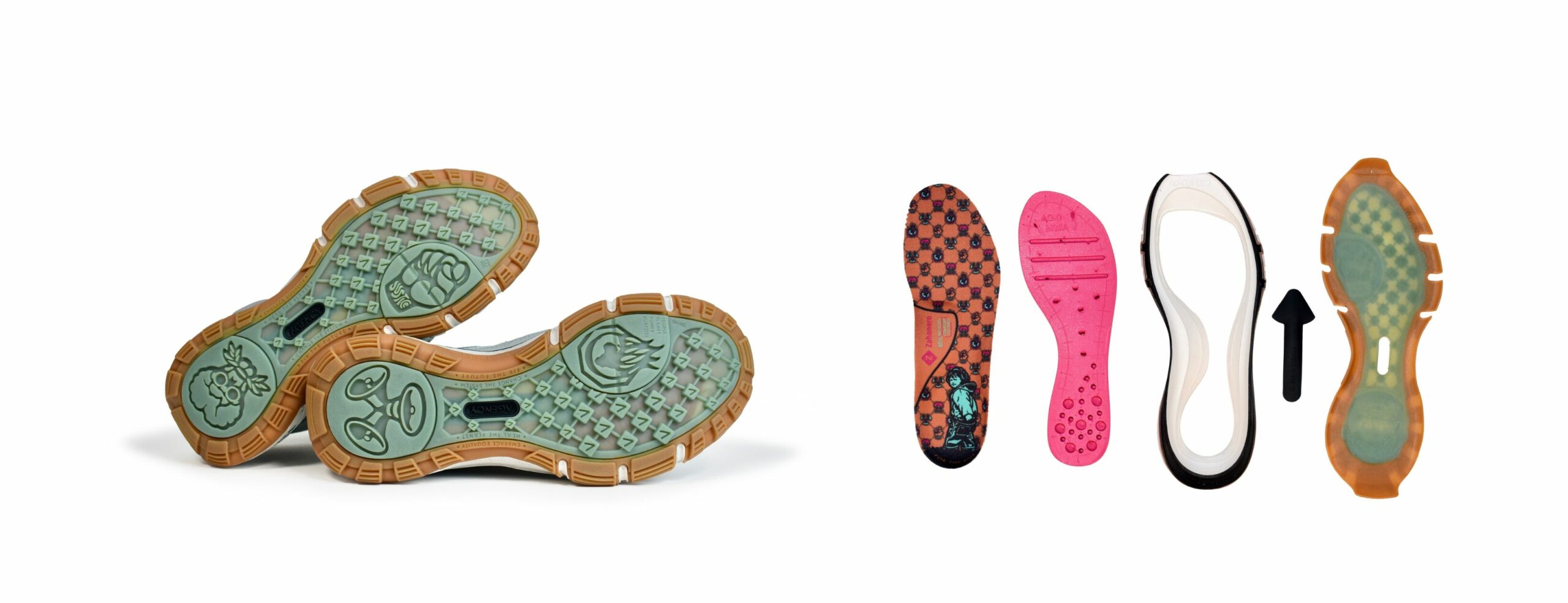
What inspired you to partner up with The Gathering for Justice, and what made them the perfect fit for this project?
I took some of my early prototypes to the United Justice Coalition Summit in Manhattan, put them on a side table, and asked people’s opinions of them. As well as they were received, the question of how they supported social justice wasn’t easy to explain without breaking down the premise of my business model. Realizing that I wouldn’t always be there to explain my shoes, I wanted an immediate and direct way to prove I wasn’t just marketing altruism but coming through on the promise. I noticed Carmen Perez-Jordan played an important role in organizing the summit both years that it happened, so I looked her up and sent a cold email to The Gathering for Justice, where she’s the CEO. She happened to respond, and from there, we met at their 1199 SEIU office, where I was further impressed by her 20-year legacy of organizing and the coalition building Harry Belafonte instilled in The Gathering when he founded it in 2005. Having previously walked 250 miles from NYC to Washington DC, Carmen was intimately familiar with the need for quality footwear with uncompromising values within the activist space and the Guardian Storm really caught her eye.
All proceeds from the Guardian sneaker go toward supporting The Gathering for Justice’s work, how will these be used to address systemic issues?
Sending proceeds to The Gathering will help them continue with their educational programs and multi-lateral coalition building utilizing Kingian nonviolence pioneered in MLK’s civil rights movement with the help of Harry Belafonte. The Gathering is also focused on ending childhood incarceration, which plays a major role in the school-to-prison pipeline, in an immediate and direct way. Each effort and action plays a role in exposing more people to the injustices in our system, inspiring more individuals to become activists every day. Carmen is also uniquely capable of organizing highly successful national protest movements as the need arises, such as when she co-chaired the Woman’s March with Tamika Mallory, Linda Sarsour, and Bob Bland.
What message do you hope this partnership sends to both the design industry and consumers about the role of brands in supporting social justice?
For the people, my hope is to let them know there’s a brand out here fighting for them. For designers, my hope is to provide them with an example of how to use their skills for the greater good. For the industry, my hope is to show that it’s financially sustainable to be in the business of altruism. For society, my hope is to help create a unified voice in the collective movement to change the system. Business as usual has enabled a modern global oligopoly to force society down a path of diminishing returns, but if enough people [I believe 16-20% of the population] shift their top priority from individual profit to collective well-being, studies show that culture change is possible. I believe we’re closer to that point than we realize, we just don’t have a single global banner to stand behind, which is what I designed AGENCY to be.
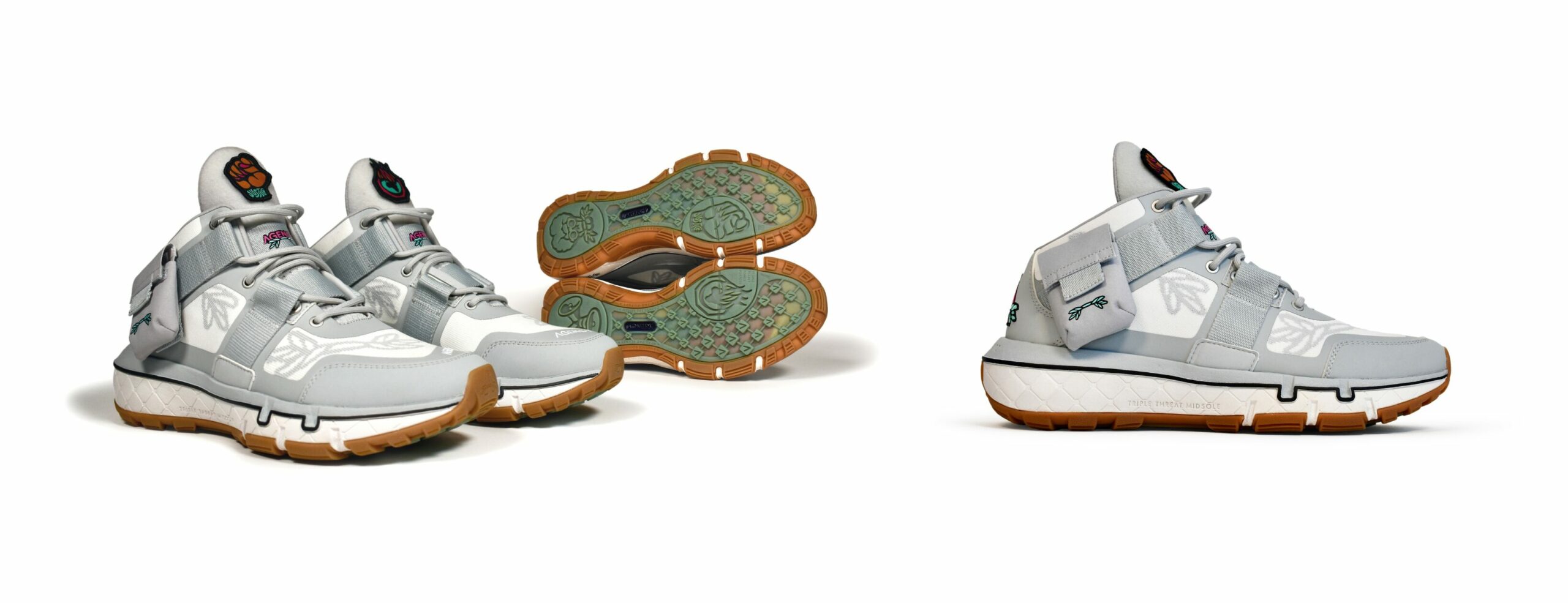
Congratulations on winning the Global Footwear Awards’ Brand of the Year! How does it feel to receive this recognition, and what does it mean for you and your team?
Thank you! Honestly, I was shocked. I thought the Guardian had a chance to win the Social Impact award because I don’t know of any other brands in that space, but to win 4 awards, including the competition’s top honor of Brand of the Year, is a real honor, especially against 250 entries from billion-dollar brand teams, super creative college students, and classically trained craftspeople. It’s crazy to me because my shoes aren’t wild, but they are well made, so I feel like the judges really wanted to highlight how it’s possible for thoughtful design to provide a practical solution to a complex problem. I also feel like they wanted to point out that now is the time to stop theorizing and start taking every stakeholder seriously.
I’m really thankful for the opportunity to speak about AGENCY Footwear in a longer form as well because designers don’t always get the chance to explain how much they care about working to create a better world.
Can you tell us about the future of AGENCY Footwear? How do you see the brand evolving, and what role do you hope it will play in inspiring the design community?
The immediate future of AGENCY Footwear is to partner with a like-minded philanthropist or impact investor who’s excited to popularize the need for systemic change in an engaging and non-confrontational way. That, along with improved distribution and sales, will enable AGENCY to scale into the exemplary creative organization and lifestyle brand that I envision. The intention is for everyone at AGENCY to be able to bring their whole self to work and connect personal stories of activism with purposeful product launches. Together, there would be no greater accomplishment than the design community playing a role in popularizing the necessary change activists have been pleading to see for centuries. It’s exciting to think that during such a pivotal time in history, design might help us finally come together as a species to fix the future.
Photo credit: Mathew Drazic, The Third Place







